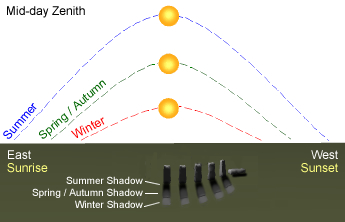Earth Seasons
A year is
the time taken for the Earth to journey once around the Sun. Q. How many days does it take for
the earth to complete one journey round the Sun? Q. How many times does the Earth
spins on its axis while it makes this journey? Q. How many months are there in
one year? Q. The Earth travels in an ellipse.
Why does it not travel in a full circle? Q. Why do we have shorter days during winter and longer days during summer? Q. Is the the Sun higher in the
sky during winter or summer ? Try
this yourself! Use a lamp (or a torch) and a ball to
investigate how the Earth moves in orbit round the Sun - Hint!.....keep the
tilt of the Earth at the same angle all the time. Why do we
have seasons ? We have different seasons because the Earth's axis is tilted at 23 and the it is divided into two hemispheres,
above and below the Equator. These are called the northern hemisphere, north of equator and southern hemisphere,
south of equator. As the Earth moves round the Sun, it is always tilted the same way, but at different times of the year
, as the Earth moves round the Sun, the hemispheres are either tilted towards
the Sun or away from the Sun. See diagram below. Try
this yourself! Again,
use a ball and a lamp (or a torch) to demonstrate the 4 seasons. Mark
the position of UK on the ball, and watch it carefully as the Earth goes round
the Sun. Hint!...... keep the ball tilted in the same direction all
the time. At position A,
it is summer in the Northern
Hemisphere and winter in the Southern
Hemisphere. At position B, it is winter in the Northern
Hemisphere and summer in the Southern
Hemisphere. Position
A Position
B In UK the 21st of March represents our spring - from here on until 21st of June the day become longer and the nights shorter. Autumn begins on 22nd of September. From here
on until 21st of December the nights become longer and the days become shorter. On the 21st of March and 22nd of September the sun is directly over the equator - this is call equinox. Well, if you look at the night sky, the stars seem to move in a circular path around the Pole Star, in the north of the sky. Yet the Pole Star appears not to be in a fixed position. This is because it is directly above the Earth's axis of rotation.
This apparent movement of the Sun and the stars is due to the rotation of
the Earth on its axis. Due to the Earth's
anti-clockwise rotation, the Sun appears to: 'Rise'
in the EAST. 'Set'
in the WEST, each day. The Sun is highest in the sky during midday. (1 pm in U.K. Summer Time and 12 noon
in winter.) The shadows caused by the Sun are always shortest at midday. During Summer the Sun rises very high in the sky. That is why the shadows are so short during summer. (See
Diagram on the left)
What is a year ?
Winter, Spring, Summer and Autumn
Does the Sun and the stars
move or is it just an illusion ?

Continue... Earth and the Moon
Tags: Earth and the seasons, Earth, Seasons